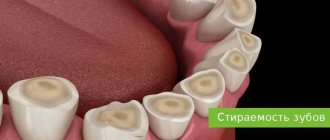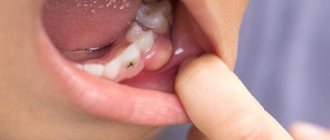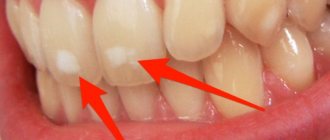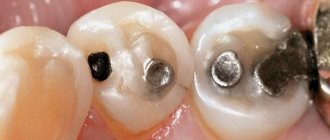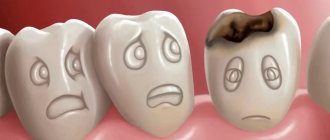10863
Teeth filing technology has been used in dental practice since the beginning of the 19th century. At that time, this procedure was used as a preservative during the treatment of caries.
With the improvement of therapy methods and the expansion of the list of instruments used, this treatment technology was abandoned, however, in some situations, filing is still used.
Indications
There are opposing opinions among dentists regarding the procedure, but there are situations in which filing is necessary:
- When installing crowns. For reliable fixation of the crown, it must fit tightly to the tooth surface.
Since the anatomical shape of each molar or incisor is not ideal, grinding down of the upper layers of their hard tissue is required. This allows you to give your own bone organ the correct geometric shape, thanks to which the manufactured product is firmly fixed and does not stand out among other elements of the jaw row. - For fixing veneers. Ceramic plates fixed to the surface of your own teeth have a certain thickness.
Therefore, in order for the installed microprostheses to fit firmly and not protrude beyond the boundaries of the native units, a small amount of hard tissue is ground off from the vestibular side of the elements of the jaw row. - Preparation for inlays. If it is necessary to mask the cavity formed as a result of carious lesions, ceramic or metal inlays can be used.
Their fixation requires the creation of side walls and the formation of the required depth near the cavity. - In case of installation of an orthodontic structure. Cutting down a small thickness of the top layer of the tooth allows you to make room for correcting the position of the remaining elements of the row without the need to remove them.
In addition, this option is often used in cases of increased crowding of teeth, since it facilitates the placement of fastening elements of the bracket system on them. - If there is damage to the enamel. Chips on the surface of the front incisors can be made less noticeable by slightly filing down the enamel.
This improves the aesthetics of the appearance of the jaw row and eliminates the need for composite restoration. - In case of elongated incisors. If the front teeth are longer than the rest of the row, this can not only cause psychological discomfort, but also interfere with correct diction or complete chewing of food.
To solve the problem, in some cases, filing the length of organs protruding from the common line is used. - At sharp angles. The anatomical structure of the anterior incisors is not always ideal. If there are sharp corners, dentists may recommend filing them down, which will increase the aesthetic appearance of the entire jaw row.
Indications for the use of orthoimplants and tactics for their installation.
Let's discuss here how the braces system works.
At this address https://orto-info.ru/ortodonticheskoe-lechenie/podgotovitelnyiy-period/separatsiya-zubov.html we will talk about abrasive teeth separation.
What is teeth filing
Teeth filing is a procedure aimed at changing their size and shape for one reason or another. Only a doctor can carry it out using special instruments.
There are situations when it is necessary to change the shape or size of dental units.
The procedure is performed before installing veneers, implants, inlays, and dentures. Indications: damage to enamel, excessive length of incisors, sharp corners.
There are two main areas in dentistry:
- Cosmetic filing.
- Sawing for medicinal purposes.
Technically, these procedures are similar to each other, but have their own nuances and different goals.
Cosmetic filing
Many dental clinics offer their patients to get a beautiful smile by filing down defective teeth. The result that can be achieved with this is the following:
- Aesthetic appearance: sharp corners are removed, teeth look neater.
- Filing down minor chips, which helps avoid the need for a complete restoration of the jaw unit.
- Alignment of teeth.
Filing for medicinal purposes
Typically, cutting down teeth for therapeutic purposes is performed before fixing artificial elements, such as crowns or veneers. The top layer of enamel in this case wears off significantly. This procedure in dentistry is called preparation.
The installation of veneers does not always involve preliminary filing of the front surface of the teeth.
In exceptional cases, enamel removal is not required. For example, when the teeth are initially small (microdentia) or when they are naturally worn down.
Dentist
Novikova Olga Alexandrovna
8 years of experience
It is important that any installed artificial element is a large product, and if the teeth are left in their original form, the final structure will be very voluminous. Also, veneers and crowns will not be able to fit harmoniously into the main row.
For veneers, teeth are ground down until the enamel is completely removed. In the case of installing crowns, the dentist makes preparations from all sides so that, as a result, all layers are removed from the tooth, which allows you to avoid possible caries and properly secure the structure. Crown grinding can be painful, which is why it is performed under anesthesia.
For several weeks after filing, a person experiences hypersensitivity of the teeth, but after a few days it goes away.
Contraindications
The necessity and admissibility of filing teeth is determined by the dentist individually in each case, since the procedure is quite labor-intensive and can be traumatic in some situations.
For this reason, sewing hard fabric is contraindicated in the following situations:
- increased abrasion of enamel;
- hyperesthesia;
- bruxism;
- presence of bad habits - frequent chewing of seeds and nuts, opening bottles with teeth;
- high risk of injury to the incisors, for example, boxing and other types of wrestling.
Structures with interlocking connections
For prosthetics of one or two teeth without turning adjacent units, the CBW prosthetic system can be used. Its features:
- Small canals with a diameter of about 1 mm and a length of 1.5-2 mm are formed on the lateral parts of the supporting teeth.
- Locks made of titanium or zirconium are inserted into these microcavities and secured with glue.
- The intermediate part of the prosthesis is fixed with installed locks.
This method makes it possible to save adjacent teeth, but it is more often used as a temporary option, since CBW systems cannot be called durable.
Technique
The procedure for filing teeth is carried out in several stages:
- Preparation. At the first meeting, the dentist assesses the condition of the patient’s jawbone elements, determines whether there is a need for cutting down hard tissue and whether there are contraindications to the procedure.
- Identifying problem areas. Using carbon paper, a liquid aerosol or a wax plate, the dentist determines the overestimated areas of the tooth. Areas that require sanding will be colored more intensely.
- Sawing. The filing procedure may vary slightly depending on the goal to be achieved and the shape of the tooth being processed.
So, when treating chewing molars, the dentist carefully grinds off the top layer of enamel from the surface of the tubercles. When cutting down the front incisors, multidirectional movements are carried out.
In some cases, it may be necessary to preliminary make a diagnostic model based on casts of the patient’s jaw rows.
The resulting gypsum sample is subjected to careful inspection and evaluation filing. Carborundum cutters or diamond burs are used as instruments for the operation
The procedure often ends with polishing and remineralization of the treated units. The dentist applies a certain composition containing a complex of useful substances to the enamel to increase the strength of the outer layer of the tooth and reduce permeability .
How do braces straighten teeth?
Let's start with braces. This is the oldest and most famous method of smile correction. For many children, wearing metal structures at one time became a real psychological trauma, but still, now many of them have straight teeth and an attractive smile. A child’s teeth and bone tissue are much more susceptible to the mechanical effects and directional changes that orthodontic systems provide. For adults, in this regard, everything is more complicated, but this does not mean that they cannot be helped. Today, there are many methods for straightening an adult’s teeth using similar structures. There are metal braces, ceramic braces, clear sapphire braces, etc. They all differ in the material from which the system is made, price, degree of visibility and aesthetics, and the type of placement. For example, vestibular braces are attached to the outside of the teeth, and lingual braces are attached to the inside, therefore they are considered less noticeable. Braces have a number of undeniable advantages. Perhaps the main one is reliability. With a properly qualified orthodontist, properly planned treatment with any brace system will almost certainly bring a positive result. At the same time, there are many nuances.
Increased sensitivity after the procedure
Many patients who have had their teeth filed complain of increased sensitivity, especially when eating hot and cold dishes and hard foods.
Dentists explain this phenomenon as follows. Dentin, located under the enamel, is penetrated by many tubules, inside of which nerve endings are located. As the thickness of the enamel decreases, pressure changes occur, which can cause pain when taking certain foods.
To reduce tooth sensitivity after the procedure, dentists recommend temporarily avoiding too hard foods, dishes with high and low temperatures, and acidic drinks.
During oral hygiene, you should use a brush with soft bristles and therapeutic and prophylactic toothpaste, rinses for sensitive teeth.
If sensitivity does not disappear a week after filing, you should contact your dentist.
Indications and contraindications for orthognathic surgery, recovery time.
In this article we will tell you how to install braces on crowns.
Follow the link https://orto-info.ru/ortodonticheskoe-lechenie/podgotovitelnyiy-period/informativnost-telerentgenogrammyi.html if you are interested in the importance of a teleroentgenogram in orthodontics.
— Popular TikTok stars are increasingly joining the fashion trend lately
— Some people claim that using a nail file they managed to make their teeth smoother and straighter
“However, dentists warn that this destroys tooth enamel and causes a lot of problems.”
Dentists have slammed a dangerous new trend on TikTok where people are grinding down their uneven teeth with a nail file.
Some influencers have recently been posting their own videos on the popular app, showing themselves participating in such a dangerous activity.
Al-Ain 07/05/2020 The Atlantic 04/26/2019
But if TikTok stars claim that this simple life hack made their smile more symmetrical, experts say this can permanently damage your teeth.
Dentists say that such opinion leaders wear away tooth enamel, which ultimately leads to the destruction of the tooth structure.
Enamel is the outer layer of the tooth that protects it from the effects of acids contained in food, and it is not restored. Due to the lack of enamel, the tooth becomes extremely sensitive and is destroyed over time by caries.
“When you remove a piece of tooth structure, you just don't know what you're doing. But you cause irreparable damage to your teeth, you destroy your teeth,” Texas dentist Chad Evans told Business Insider.
In June, aspiring TikTok star Mia Dio became one of the first users to post a video of herself grinding down her teeth. This video has received more than 50,000 likes.
“I file my teeth down with a nail file because they are not perfect. And we'll save a lot of money... warning about a possible negative reaction! " she tells her fans, waving a nail file.
“It really works!” she enthuses later.
Many of her most impressionable fans left comments like: “I've thought about doing the same thing so often. God, they look great!”
Another fan ecstatically whispers: “I made this last week! The result is obvious!”
However, experts through TikTok criticize such statements, trying to convince users that such methods of fighting for beauty are very dangerous. Detroit dentist Z. Mackie posted her own video online explaining why users shouldn't put a nail file in their mouth. “There is nothing good about grinding down your teeth with a file... It significantly increases their sensitivity,” she said.
“If you wear down too much, you'll have to get a filling or a crown,” adds Dr. Mackey, noting that such a trip to the dentist can be expensive.
InoSMI materials contain assessments exclusively of foreign media and do not reflect the position of the InoSMI editorial staff.
At home
Fear of doctors and thoughts about the pain of professional manipulations often lead to patients trying to cope with the existing problem on their own. Teeth filing is also no exception.
Dentists share their experience that people often come to appointments whose enamel has been severely damaged by attempts to cut off part of it with various improvised tools in the desire to improve the aesthetic appearance of the jaw row with prominent front teeth or the presence of chips.
In addition to the problem of high sensitivity, these patients experience cracks in the hard tissue, as well as dentin damage, which develops as a result of bacteria entering the dentinal tubules through open pores.
The consequence of such independent actions can be the development of caries, pulpitis and numerous complications that can lead to partial or complete tooth destruction.
Dentists categorically prohibit performing teeth filing procedures at home. Only a specialist can determine the need for an operation to remove a section of enamel and carry it out efficiently, without the risk of complications.
How to straighten your front teeth?
The question of how to straighten the front teeth worries most people who want to start orthodontic treatment. This need is understandable. The incisors and canines are the so-called smile zone, i.e. the most noticeable and prominent teeth. Often crooked and protruding front teeth can have a significant impact on your smile and facial expression. Treatment can be carried out with both braces and mouth guards. The rehabilitation plan is drawn up in such a way that the orthodontic structure has a systematic effect on the crooked front teeth and gradually brings them to the optimal position. In some cases, bite correction in adults occurs through surgery or veneers, but these manipulations are no longer considered orthodontic treatment.
Price
The cost of filing teeth depends on the reasons for which it is carried out and what result is needed to achieve:
- preparation for caries - from 200 to 350 rubles per row element;
- treatment of enamel after removing braces – 550-650 rubles;
- identification of traumatic occlusion and grinding of one tooth – 200-300 rubles;
- cutting down a tooth for a crown – 130-200 rubles;
- filing a molar under an orthodontic structure – 150-200 rubles.
Find out how teeth are prepared in the video.
Veneers with minimal grinding of teeth
The thinner the veneer, the less you need to grind off the enamel before installing a microprosthesis. The table below will help you compare the characteristics of different types of structures and choose the best option with the least grinding of teeth and optimal cost.
Composite veneers
Manufacturing type:
Formed immediately in the patient’s oral cavity
Thickness:
0.3 - 0.6 mm
Turning:
No
Price in Moscow:
from 5,000 rub.
- Speed of production.
- Installation without grinding teeth.
- Acceptable price.
- Short service life.
- Variability of color.
- Fragility.
- Insufficient aesthetics.
- Poor ability to hide dental defects.
Ceramic veneers
Manufacturing type:
Produced in a dental laboratory
Thickness:
0.5 mm
Turning:
Yes
Price in Moscow:
from 14,000 rub.
- Aesthetics.
- Reliability.
- Color constancy.
- Durability.
- High price.
- Irreversibility of turning a tooth under a ceramic veneer.
- Long production time.
Zirconium veneers
Manufacturing type:
Produced in a dental laboratory
Thickness:
0.5 - 0.7 mm
Turning:
Yes
Price in Moscow:
from 17,000 rub.
- Aesthetics.
- Durability.
- Strength.
- High price.
Adhesive prostheses
This is a relatively new technique for restoring the integrity of the dentition with minimal preparation of supporting units. At the same time, the latter are not depulped, that is, they remain “alive”. And they are not covered with artificial crowns. To install an adhesive prosthesis:
- Shallow grooves are sawed on the teeth adjacent to the defect;
- a prosthesis on a beam is installed in the prepared “niches”;
- From above, the fixation site is covered with composite materials.
Adhesive prosthetics is a progressive and affordable alternative to the installation of metal-ceramic bridge structures. One of its advantages is the ease of replacing such a system if the patient desires to choose a different method of dentition restoration.
